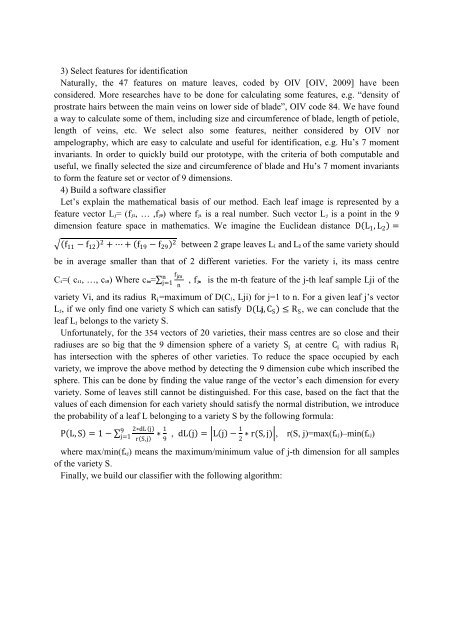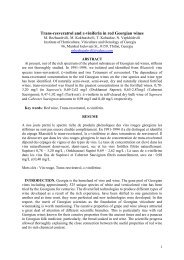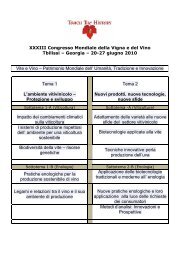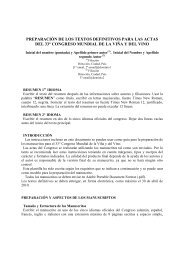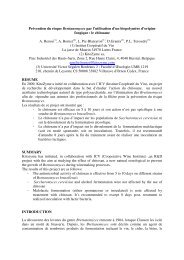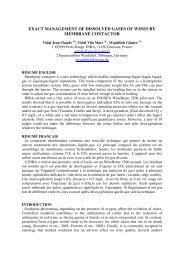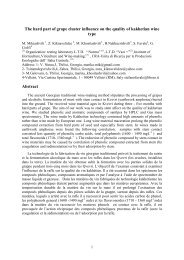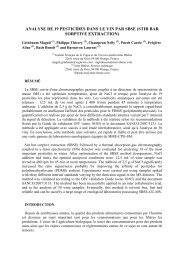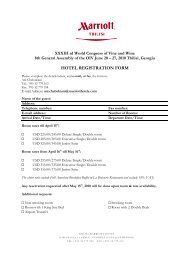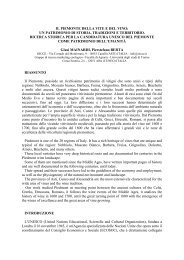Identification of Grape Varieties via Digital Leaf Image ... - Oiv2010.ge
Identification of Grape Varieties via Digital Leaf Image ... - Oiv2010.ge
Identification of Grape Varieties via Digital Leaf Image ... - Oiv2010.ge
You also want an ePaper? Increase the reach of your titles
YUMPU automatically turns print PDFs into web optimized ePapers that Google loves.
3) Select features for identification<br />
Naturally, the 47 features on mature leaves, coded by OIV [OIV, 2009] have been<br />
considered. More researches have to be done for calculating some features, e.g. “density <strong>of</strong><br />
prostrate hairs between the main veins on lower side <strong>of</strong> blade”, OIV code 84. We have found<br />
a way to calculate some <strong>of</strong> them, including size and circumference <strong>of</strong> blade, length <strong>of</strong> petiole,<br />
length <strong>of</strong> veins, etc. We select also some features, neither considered by OIV nor<br />
ampelography, which are easy to calculate and useful for identification, e.g. Hu‟s 7 moment<br />
invariants. In order to quickly build our prototype, with the criteria <strong>of</strong> both computable and<br />
useful, we finally selected the size and circumference <strong>of</strong> blade and Hu‟s 7 moment invariants<br />
to form the feature set or vector <strong>of</strong> 9 dimensions.<br />
4) Build a s<strong>of</strong>tware classifier<br />
Let‟s explain the mathematical basis <strong>of</strong> our method. Each leaf image is represented by a<br />
feature vector Lj= (fj1, … ,fj9) where fji is a real number. Such vector Lj is a point in the 9<br />
dimension feature space in mathematics. We imagine the Euclidean distance D L 1 , L 2 =<br />
f 11 − f 12 2 + ⋯ + f 19 − f 29 2 between 2 grape leaves L1 and L2 <strong>of</strong> the same variety should<br />
be in average smaller than that <strong>of</strong> 2 different varieties. For the variety i, its mass centre<br />
Ci=( ci1, …, ci9) Where cim=<br />
n<br />
f jm<br />
j=1 , fjm is the m-th feature <strong>of</strong> the j-th leaf sample Lji <strong>of</strong> the<br />
n<br />
variety Vi, and its radius R i =maximum <strong>of</strong> D(Ci, Lji) for j=1 to n. For a given leaf j‟s vector<br />
Lj, if we only find one variety S which can satisfy D(Lj, C S ) ≤ R S , we can conclude that the<br />
leaf Lj belongs to the variety S.<br />
Unfortunately, for the 354 vectors <strong>of</strong> 20 varieties, their mass centres are so close and their<br />
radiuses are so big that the 9 dimension sphere <strong>of</strong> a variety S i at centre C i with radius R i<br />
has intersection with the spheres <strong>of</strong> other varieties. To reduce the space occupied by each<br />
variety, we improve the above method by detecting the 9 dimension cube which inscribed the<br />
sphere. This can be done by finding the value range <strong>of</strong> the vector‟s each dimension for every<br />
variety. Some <strong>of</strong> leaves still cannot be distinguished. For this case, based on the fact that the<br />
values <strong>of</strong> each dimension for each variety should satisfy the normal distribution, we introduce<br />
the probability <strong>of</strong> a leaf L belonging to a variety S by the following formula:<br />
P L, S = 1 −<br />
9 2∗dL j<br />
j=1 ∗ 1 , dL j = L j − 1 r S,j 9 2<br />
∗ r(S, j) , r(S, j)=max(fsj)–min(fsj)<br />
where max/min(fsj) means the maximum/minimum value <strong>of</strong> j-th dimension for all samples<br />
<strong>of</strong> the variety S.<br />
Finally, we build our classifier with the following algorithm:


